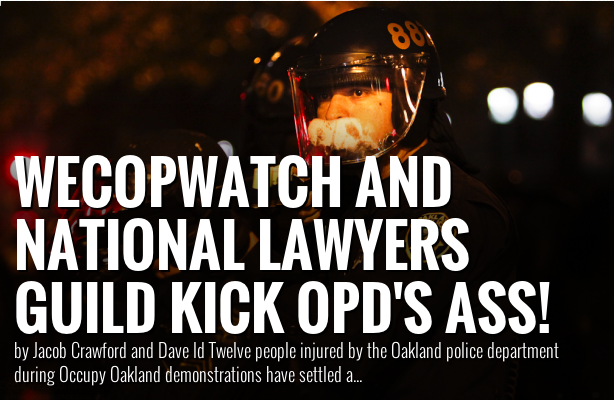
by Jacob Crawford and Dave Id
Image by Elijah Nouvelage
Twelve people injured by the Oakland police department during Occupy Oakland demonstrations have settled a federal civil rights lawsuit with the city of Oakland for a total of $1.17 million. The injuries came as a result of OPD’s violent response to Occupy Oakland on October 25 and November 2, 2011. The settlement in the Campbell vs. City of Oakland case comes on the heals of another $1 million settlement still pending final approval,
Spalding vs.City of Oakland.
As a result of both cases, OPD has agreed to allow the federal court to enforce OPD’s compliance with its own crowd control policy and to negotiate with the National Lawyers Guild (NLG) and ACLU before making any changes to the policy, which prohibits police from shooting “less lethal” impact munitions or tossing explosive teargas grenades into crowds, and prohibits mass arrests without warning or opportunity to disperse.
The videos below document the cases of four of the Occupy Oakland plaintiffs in two separate incidents. The videos reveal police violence through the video of plaintiffs, witnesses, and neverbeforeseen Oakland police chest cameras.
While there were many incidents investigated in the Occupy Oakland Campbell lawsuit, the following two incidents of police violence have similarities that underscore serious problems within the Oakland Police Department.
The first video below is of Scott Campbell being shot by a leadshot filled beanbag round following Oakland’s General Strike on the night of November 2, 2011.
In the case of Scott Campbell, the command to shoot anyone crossing an invisible line is illegitimate. How could people know they were in harm’s way? Less than lethal weapons are supposedly intended for situations where violence is taking place and the officer needs to defend themselves and other officers. This is simply not the case with Scott Campbell. As you can see in the video Scott is not approaching the line, but rather walking parallel to it. As you can see Oakland police officer Victor Garcia waits until Campbell is almost out of view to fire at him. Not because Campbell suddenly takes a turn towards the police line, or poses a threat, but Garcia fires at him because he can see that Campbell was just an inch over the invisible line marked by a roll of toilet paper. Garcia didn’t shoot to defend or protect, he shot because he knew he could get away with it by deliberately misinterpreting his commander’s order to fire at anyone who crossed the invisible line.
The second video below is of the violent arrests of Brooke Anderson, Max Alper, and Kevin Christensen following the raid of Occupy Oakland on the morning of October 25, 2011.
Those people attacked and arrested had done nothing wrong. You can see Oakland police officer Cesar Garcia goes into the crowd with his baton ready, and ends up striking Max Alper several times. Then later he is caught on video visibly upset that he has to document his use of force in a report because he “jabbed one of the fat things friendly.”
After you have watched both videos, consider:
1. Both Garcias have been in multiple officer involved shootings. Victor Garcia has shot two people as well as an arthritic dog that posed no threat. Cesar Garcia has also been in multiple officer involved shootings. (see Jones vs Oakland reference at http://www.indybay.org/newsitems/2013/02/06/18731467.php)
2. Both officers were under the command of officers who have been involved in shootings. Oakland police Captain Ersie Joyner has been in involved in five shootings, one with Cesar Garcia in fact, and Oakland police lieutenant Fred Mestas has been involved in at least two shootings.
3. Both Garcias showed premeditation in their acts of violence. Victor Garcia knowing the order was to shoot anyone who crossed the invisible line, trained his gun on Scott Campbell as he walked parallel to the line and waited until he saw that Campbell was just an inch past the line before shooting. Cesar Garcia was the only cop who had his baton out ready to swing when Lt Mestas ordered the arrests.
4. In both incidents, both officers used excessive violence not merely because they are violent officers but, more importantly, because they knew they could get away with it. Joyner and Mestas were both responsible for the incidents and the actions of
their subordinates.
While the both Garcia’s need to be held accountable for their actions, both Joyner and Mestas should be held to even higher standards as commanding officers. But in Oakland as you can see, you’re more likely to be promoted if you shoot people. . .
National Lawyers Guild Press release
And check out the National Lawyers Guild’s settlement with OPD for wrongfully arresting Oscar Grant Protesters in 2010
Right Here
If you like what you have seen or read feel free to
Like us at https://www.facebook.com/WeCopwatch
Donate at https://www.wepay.com/donations/wecopwatch
Check out more of out content at http://wecopwatch.org/
Watch Videos at http://www.youtube.com/WeCopwatch
Check up on us at https://twitter.com/WeCopwatch
